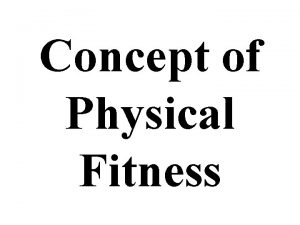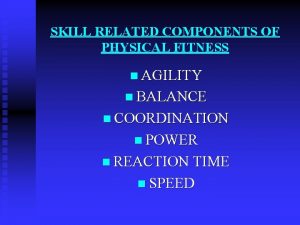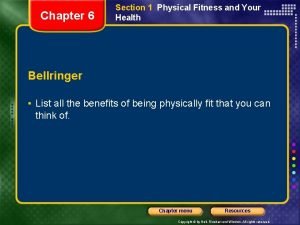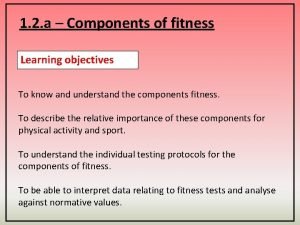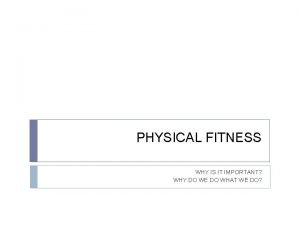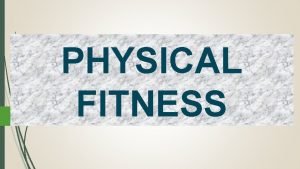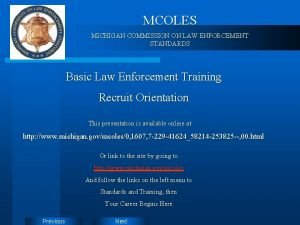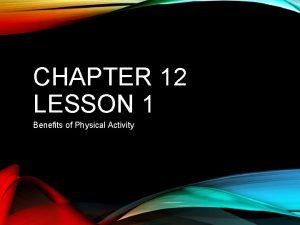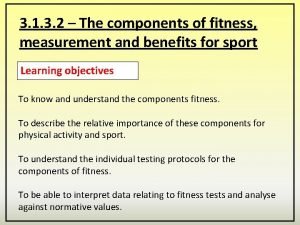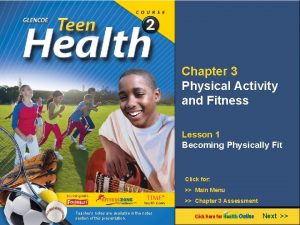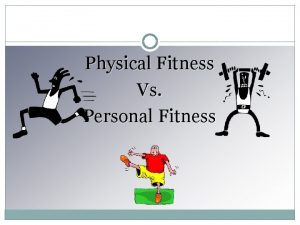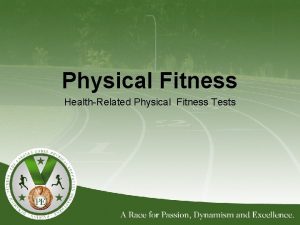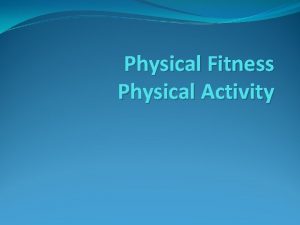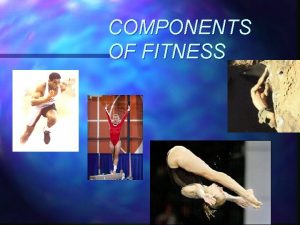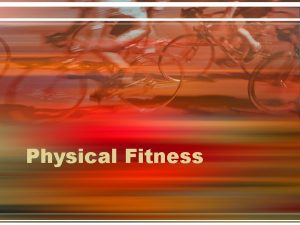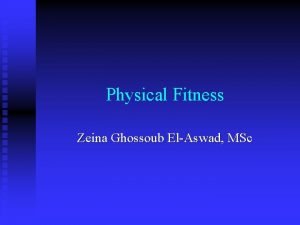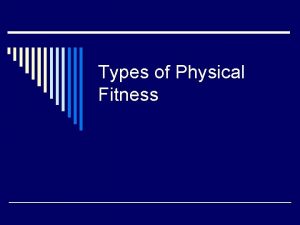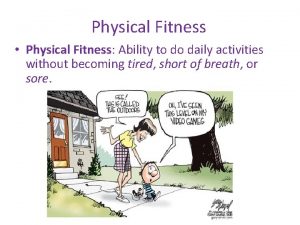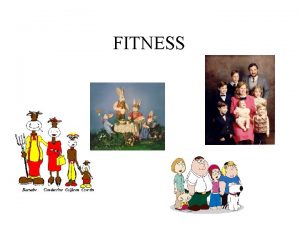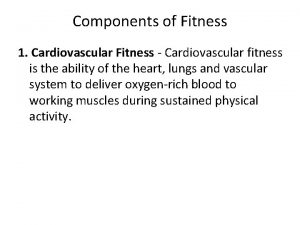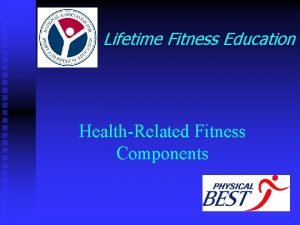Concept of Physical Fitness What is Physical Fitness































- Slides: 31

Concept of Physical Fitness

What is Physical Fitness? Physical Fitness is the ability of your body systems to work efficiently. A fit person is able to carry out the typical activities of living, such as work, and still have enough energy and vigor to respond to emergency situations and to enjoy leisure time activities.

• Physical activity is a general term that includes sports, dance, and activities done at work or at home, such as walking, climbing stairs, or mowing the lawn. • When people do physical activity especially for the purpose of getting fit, we say they are doing exercise.

Definitions of Fitness “The ability to perform muscular work satisfactorily. ” WHO, 1971 “A set of attributes that people have or achieve that relates to the ability to perform physical activity. ” CDC, 1985 “The ability to carry out daily tasks with vigor and alertness, without undue fatigue and with ample energy to enjoy leisure pursuits and to meet unforeseen emergencies. ” Presidents Council of Fitness and Sports, 1971.

The Parts of Physical Fitness: 1. Health - Related Physical Fitness It helps you stay healthy 2. Skill - Related Physical Fitness It helps you perform well in sports and activities that require certain skills

Concept of Motor Fitness

What is ‘Motor’ Fitness ? Motor Fitness is also known as ‘Skill Related Fitness’ and this gives us a clue as to how these qualities help us when playing a game. Skill is the learned ability to carry out the result you want with maximum certainty and efficiency.

Component of Motor Abilities

Endurance: Endurance is one of the most important conditional activity, which is primarily determined by the energy liberation process. Endurance is directly or indirectly of high importance in all the sports. “Endurance may be define as the ability to perform the sports movement with desire quality and speed under the condition of fatigue” “Endurance may be define as the ability to resist fatigue”.

Importance of Endurance: 1. Endurance enable the sportsman to maintain an optimum pace during competition. 2. It ensure good quality of technical skills e. g. accuracy, perfection and rhythmical movement. 3. It enable to take higher training load. 4. Ability to recover quickly during the competition. 5. It enable to remain alert and attention during the game. (injury can be avoided)

Type of Endurance: 1. According to nature of activity: a. Basic Endurance: It is the ability to resist fatigue caused by activity done at slow to moderate pace; walking, slow jogging, running etc. b. General Endurance: it is the ability resist fatigue caused by various type of aerobic and anaerobic activities. Abilities to do all shot of activities, aerobic or anaerobic for sufficient long time without getting tired. E. g. playing any games.

c. Specific Endurance: it is the ability to resist fatigue caused by specific sports activity. E. g. long distance run. 2. According to the duration of activity: It is the ability of an individual to perform cyclic type of movement under the condition of fatigue, which generally last from 45 sec. to 40 mins e. g. swimming, running, cycling etc.

Strength is also another important motor ability which is produce by the reduce of energy from the muscles during the voluntary contraction. “Strength is the ability of a muscles to get over resistance”. E. g. throwing, weight lifting, jumping, wrestling etc.

Types of Strength: 1. Maximum Strength: Ability of an individual to overcome the maximum possible resistance in a single muscular contraction. E. g. weight lifting 2. Explosive Strength: Ability of an individual to overcome the resistance with high speed. E. g. running, hitting, throwing etc. 3. Strength Endurance: Ability of a muscle to get over the resistance with medium intensity for a long period of time. E. g. long distance swimming, cycling etc.

Principles of Strength Training: 1. Analysis of different kind of muscles (voluntary muscles) 2. A separate training for each muscles. 3. Body measurement 4. Distinguish between general and specific exercise. 5. Do not change the programme, let it continue for few days. (adaption) 6. Variety of exercise are to be used. 7. Determine total amount of load. 8. Medium intensity exercise should be given daily.

Guideline for Strength Training: 1. Training programme should begin with warming up and end up by cooling down exercise. 2. Mobility and stretching exercise should be included to ensure full range of motion. 3. Back/spine should be kept straight during strength training. 4. Breathing rate should be normal. 5. Maximum strength training should avoid the condition of fatigue. 6. Preventive measures are to be taken during training.

7. Training equipment should be in good condition. 8. Strength training needs long recovery. 9. While tackling heavy resistance, help of assistance to be taken. 10. Programme should be planned as per the game. 11. A proper discipline is to be maintain in the training.

Speed In simple term it is the distance covered in per unit time. Speed is recorded mt/sec. or km/hr e. g. sprinter run 100 mts in 10 sec. speed= 10 mts/sec In sports Speed may be define as the ability to execute motor action or movement under a given condition in a minimum possible time. In other words Speed may be define as the capacity of an individual to perform successive movement of the same pattern at the fast rate.

Like strength and endurance, Speed is a conditional ability which depend upon the central nervous system, If we look in a complex nature of movement of different games and sports, there are certain events which requires some distance to be covered in a cyclic movement. E. g. 100 mts sprint. But in boxing the desire to perform certain movement with great speed in which the sportsman do not need to travel the distance. This type of movement is called as cyclic movement.

Types of Speed: 1. Reaction Speed 2. Movement Speed 3. Acceleration Speed 4. Locomotion Speed 5. Speed Endurance

1. Reaction Speed: It may be define as the ability of an individual to react effectively to a given signal/stimulus as quick as possible. It is the time gap between the stimulus and the response. E. g. 100 mts – reaction at the gun fire. 2. Movement Speed: Movement Speed may be define as the ability to execute single movement in minimum time.

3. Acceleration Speed: It may be define as the ability of an individual to achieve high Speed of locomotion from a stationary position in a minimum possible time. 4. Locomotion Speed: It may be define as the ability of an individual to maintain the maximum possible speed relatively for a longer duration. E. g. skating, rowing 5. Speed Endurance: it is the ability of an individual to perform motor movement as quickly as possible under the condition of fatigue.

Flexibility The ability to perform movement with greater range or large amplitude. Flexibility may be define as “the ability to execute movement with greater amplitude or range”. Importance of Flexibility: 1. It is the fundamental requirement for a quantitative and qualitative execution of movement.

2. Greater range of movement enable the muscles to develop more force and speed. 3. Adequate flexibility leads faster skill execution and perception. 4. Adequate flexibility helps in prevention of injuries. 5. Flexibility allows movement in muscles tension and internal resistance to both movement and energy economic.

Types/Forms of Flexibility: 1. Passive flexibility: Ability to perform movement with great range with external help. e. g. stretching exercise with partners. 2. Active flexibility: Ability to perform movement with greater amplitude without the external help, but with the helps of muscles force only.

Active flexibility is of two types: a. Static Flexibility b. Dynamic Flexibility Static Flexibility: Static flexibility can be done by sitting or standing. Dynamic Flexibility: Dynamic flexibility is done during the motion. E. g. running, jumping, kicking etc.

Agility is the ability to change direction and stop quickly.

Co-ordination ability may be understood as a relatively stabilized and generalized pattern of motor control and regulation process. This enable the sportsman to do a group of movement with quality and effort. Is the ability of the body and senses to work together to produce fluent and controlled movement. E. g. Tennis serve relies heavily on Coordination as the eyes, hand body must work smoothly to control the swing of the racket to meet the ball in the centre of the racket.

Characteristics of Co-ordination: 1. The co-ordination ability has a direct linkage with a technical aspects of sports performance. 2. The efficient functioning of central nervous system and movement perception of various sense organ are essential for improvement of co-ordination ability. 3. In games and sports, movement of any skills are performed in different combination of coordination ability.

4. To get mastery over any skill, co-ordination is the primary requirement. E. g. when the body is in dynamic state, balance ability to maintain the flow of movement. Exercise on balancing bar in gymnastics. 5. Application of co-ordination ability in general or specific. E. g. balance ability may be general for long distance runner and specific for gymnastics. 6. Performance is effected by coupling ability, this coupling ability appears in different combination.

Importance of Co-ordination ability: 1. Co-ordination ability are important for learning new skills and technique. 2. Influence the continuous modification of skill. 3. Quality of sports movement highly depend on coordination ability. 4. Co-ordination ability contributes for better selection of sportsman. 5. High sports performance largely depends on coordination ability. 6. It is required for better application of technique and tactics movement.
 Concept of physical training
Concept of physical training What is physical fitness test in mapeh
What is physical fitness test in mapeh Health-related
Health-related New venture fitness drinks concept statement
New venture fitness drinks concept statement Gumshoe research example
Gumshoe research example Self real y self ideal
Self real y self ideal Contoh marketing concept
Contoh marketing concept Health related fitness
Health related fitness Presidential physical fitness test definition
Presidential physical fitness test definition Mapeh pe grade 7
Mapeh pe grade 7 Personal fitness merit badge requirements
Personal fitness merit badge requirements 2 types of physical fitness
2 types of physical fitness Hexagon agility test clockwise and counterclockwise
Hexagon agility test clockwise and counterclockwise Section physical fitness and your health
Section physical fitness and your health Chapter 12 physical activity and fitness
Chapter 12 physical activity and fitness Physical fitness components of stork balance
Physical fitness components of stork balance Physical fitness
Physical fitness What component of fitness is 90 degree push up
What component of fitness is 90 degree push up Physical fitness definition
Physical fitness definition Physical fitness notes
Physical fitness notes Components of fitness worksheet
Components of fitness worksheet Mcoles standards
Mcoles standards Phonons of physical fitness
Phonons of physical fitness 2 types physical fitness
2 types physical fitness Chapter 6 physical fitness for life
Chapter 6 physical fitness for life A physical education chapter 12
A physical education chapter 12 Wall toss normative data
Wall toss normative data 6 skill related fitness
6 skill related fitness Elements of physical fitness
Elements of physical fitness Health related physical fitness definition
Health related physical fitness definition Alabama physical fitness assessment
Alabama physical fitness assessment Physical fitness is the ability to
Physical fitness is the ability to
